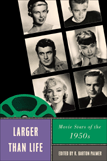| R. Barton Palmer (ed.), Larger than Life: Movie Stars of the 1950s Rutgers University Press, 2010 ISBN: 978-0-8135-4767-1 US$24.95 (pb) 272pp (Review copy supplied by Rutgers University Press) |
 |
Larger Than Life: Movie Stars of the 1950s, is part of a series from Rutgers University Press called ‘Star Decades: American Culture/American Cinema’. This book was edited by R. Barton Palmer, who also writes the introduction and conclusion, thus providing a useful bookend for understanding the articles in dialogue with one another. In his introduction, he explains the national, local, and industrial circumstances of the 1950s, including the outlawing of studios’ vertical integration, the resulting package-unit system of distribution, and the decline of movie-going occurring as a result of the suburban sprawl. Palmer looks toward the 1960s in his conclusion, explaining how the 1950s ‘cinema of sentiment’ changes into a 1960s ‘cinema of sensation’, illustrated by the murder of the star and the subsequent thrills and chills of Hitchcock’s 1960 film, Psycho (1960). A major point in Palmer’s introductory argument is that the 1950s Hollywood studio system turned out two forms of product that, in turn, correspond to two schools of acting. The first kind of film was the more conventional “escapist” fare – genre films, actions and adventures – the latter character-centered dramas built around the starring performances of Method actors like James Dean and Marlon Brando. Method acting, an approach to acting pioneered by Strasberg, is born out of Stanislavki’s theories, which are, ironically, anti-star or anti-type.
Palmer elaborates on this dichotomy in his essay ‘Charlton Heston and Gregory Peck: Organization Men’. Heston and Peck represent the two modes of films that characterize 1950s Hollywood output, with the former a ‘physical’ performer and the latter a more internally-oriented actor, having trained in the Meisner approach, a subset or variation on Strasberg’s Method. Heston’s performances did not invite close-ups – his presence and talent stems from his athleticism and his willingness to be dressed up, painted, and positioned by the director. Peck, whose marked-up scripts serve as a testament to his close reading, turned in performances that may not have corresponded to the director’s vision but drew attention from audiences and critics as being impressively serious or intense. Palmer defends Heston’s admirable efforts, in that his performances suited the action genre entirely, but concedes that if Peck is an actor-Auteur, then Heston is an able metteur-en-scène. This essay can and should be read alongside Susan White’s ‘Marlon Brando: Actor, Star, Liar’, a theoretically complex treatment of Brando’s relationship to Method and what constitutes ‘realistic performance’. White’s ultimate decision to define Brando’s realism as a series of “facial microsequences… or action units with microscopic accuracy” (179) is compelling, if somewhat empirical in scope, and might be useful when considering contemporary stereotypes of Method performances so ‘real’ that they are barely presentable, with actors who squint, slouch, twitch, and mumble.
A notable highlight of this anthology is Foster Hirsch’s ‘Doris Day and Rock Hudson: The Girl Next Door and the Brawny He-Man’. Hirsch considers the twin careers of Day and Hudson up to their ‘meet-cute’ in 1959’s Pillow Talk. While Hudson’s role in this romantic comedy was a stepping stone for the actor, proving he could do light comedy, for Day it was merely an extension of her spunky, steely star image. Of particular interest is the way in which Hirsch traces Day’s earlier career, the miscasting she faced at Warner Bros. and the typecasting she failed to overcome afterwards. Another high point in the collection is William A. Brown’s essay ‘Audrey Hepburn: The Film Star as Event’. Brown’s question is deceptively simple: it is how and why Hepburn became a movie star. Hepburn rose to fame in large part due to her ‘virtual’ qualities – her androgyny, her ambiguous nationality, her beauty that could become or be mistaken for plainness. While grappling with the works of Roland Barthes and complexity theorist Steven Johnson, Brown situates Hepburn’s star text within the larger historical narratives of the “Europeanization’ of Hollywood” (154) and the studios’ commitment to providing “spectacular cosmopolitanism” (131) on the big screen.
While an absorbing read throughout, this anthology perpetuates two methodological missteps. First, there is, to my mind, a privileging of biographical information that stands in the way of more penetrating analysis. That Montgomery Clift was a closeted homosexual working in Hollywood is not throw-away knowledge, but it does not follow that he and Elizabeth Taylor managed chemistry on-screen as a result of their relaxed, platonic off-screen friendship.1 That presumes too much both of the nature of on-screen chemistry, not to mention the specifics of Clift’s sexuality. Second, there is a general presumption that the 1950s was a period of American history in which all women were expected to vacuum in heels and all men wore gray flannel suits. To consider this decade as monolithic in attitude and morality is reductive in scope, a historiographic problematic that has been addressed in, for one, the 1994 anthology Not June Cleaver: Women and Gender in Postwar America, 1945-1960 (1994). Issues of race and class factor heavily into gender expectations and identities, such that one masculinity could never satisfy or speak to all American audiences. Further, Clift, Brando, Jerry Lewis, Hudson, and James Mason, are each described as challenging conventional 1950s masculinity. With these many challengers to traditional manhood, who is left to uphold convention? Perhaps, instead, the category of ‘masculine’ was more fluid and capacious than is understood here. The study of stars and the star system can allow scholars the opportunity to break down preconceived stereotypes of the past, rather than shore them up, and to expose the 1950s as an ideologically vast and contradictory time: one not so different, then, from our own.
Anne Berke
Yale University, USA
1 The article in the anthology is “Montgomery Clift: Hollywood Pseudohomosexual” by Tison Pugh and Barry Sandler,
